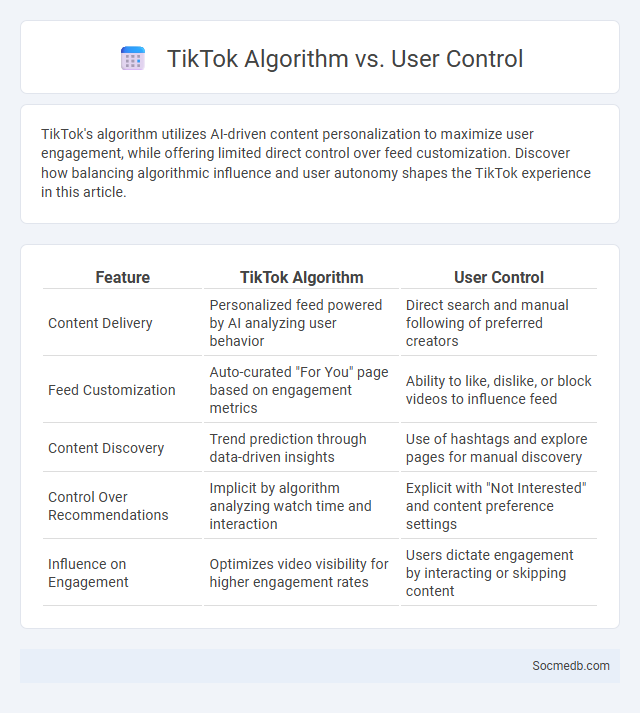
Photo illustration: TikTok Algorithm vs User Control
TikTok's algorithm utilizes AI-driven content personalization to maximize user engagement, while offering limited direct control over feed customization. Discover how balancing algorithmic influence and user autonomy shapes the TikTok experience in this article.
Table of Comparison
| Feature | TikTok Algorithm | User Control |
|---|---|---|
| Content Delivery | Personalized feed powered by AI analyzing user behavior | Direct search and manual following of preferred creators |
| Feed Customization | Auto-curated "For You" page based on engagement metrics | Ability to like, dislike, or block videos to influence feed |
| Content Discovery | Trend prediction through data-driven insights | Use of hashtags and explore pages for manual discovery |
| Control Over Recommendations | Implicit by algorithm analyzing watch time and interaction | Explicit with "Not Interested" and content preference settings |
| Influence on Engagement | Optimizes video visibility for higher engagement rates | Users dictate engagement by interacting or skipping content |
Understanding the TikTok Algorithm: An Overview
The TikTok algorithm prioritizes content based on user interactions, video information, and device settings to personalize your feed effectively. By analyzing factors such as video likes, shares, comments, watch time, and content type, TikTok delivers tailored recommendations that keep users engaged. Understanding these elements helps you optimize content creation and increase visibility on the platform.
How TikTok Personalizes Your Feed
TikTok personalizes your feed by using a sophisticated algorithm that analyzes your interactions, such as likes, shares, watch time, and comments, to deliver content tailored to your preferences. The platform's machine learning models continuously process this behavioral data in real-time, refining recommendations to increase user engagement and retention. Factors like video information, device settings, and user location also contribute to the dynamic customization of the For You Page, ensuring a uniquely personalized experience.
The Balance Between User Control and Platform Automation
Striking the right balance between user control and platform automation is essential for optimizing your social media experience. Advanced algorithms curate content to keep you engaged while personalized settings allow you to manage privacy, notifications, and content preferences. Ensuring transparency in automated decisions empowers you to maintain control over your digital footprint and enhances overall platform trustworthiness.
Algorithmic Bias: What It Means on TikTok
Algorithmic bias on TikTok refers to the tendency of the platform's recommendation engine to favor certain types of content, creators, or demographics, often reinforcing existing stereotypes or marginalizing underrepresented groups. This bias stems from the platform's use of machine learning models trained on historical user engagement data, which can inadvertently prioritize popular or mainstream content while limiting diversity and inclusivity. Understanding TikTok's algorithmic bias is essential for promoting equitable content discovery and supporting diverse voices within the social media ecosystem.
Factors Influencing Content Recommendation
Algorithms analyze your interaction history, including likes, shares, and watch time, to tailor content recommendations on social media platforms. User demographics such as age, location, and language also play a crucial role in personalizing the content feed to match your preferences. Contextual factors like current trends, trending hashtags, and time of day dynamically influence the visibility and ranking of recommended posts.
User Agency: Adjusting Preferences and Feedback
User agency on social media platforms is empowered through customizable settings that allow you to adjust preferences such as content visibility, notification choices, and privacy controls. Providing direct feedback on posts and algorithms enables platforms to fine-tune your experience, ensuring relevant and engaging content delivery. Active management of these features helps optimize your social media environment, enhancing both control and satisfaction.
The Impact of Algorithmic Bias on Content Diversity
Algorithmic bias in social media platforms often skews content visibility, resulting in reduced diversity by prioritizing certain viewpoints or demographics. This selective exposure limits user access to a broad spectrum of ideas and reinforces echo chambers, affecting public discourse. Addressing these biases through transparent algorithm design and inclusive data training is crucial for enhancing content diversity and fostering equitable information ecosystems.
Privacy and Data Usage in TikTok's Algorithm
TikTok's algorithm collects extensive user data, including location, device information, and interaction patterns, to personalize content feeds. Privacy concerns arise from the platform's data-sharing practices with third parties and potential access by foreign entities. Users should review TikTok's privacy settings to control data usage and protect their personal information effectively.
Strategies for Greater User Control and Transparency
Social media platforms increasingly implement strategies for greater user control and transparency by empowering users with customizable privacy settings and detailed data access controls. Enhanced transparency reports and clear policies enable Your informed decisions regarding data sharing and content visibility. Leveraging these tools helps maintain trust while promoting a safer, more personalized online experience.
Future Trends: Evolving Algorithms and Fairness on TikTok
TikTok's future trends emphasize evolving algorithms designed to enhance user engagement by delivering more personalized content while addressing concerns about fairness and bias. Your experience on TikTok will be shaped by improved transparency and ethical AI practices that aim to promote diverse and inclusive content. These advancements ensure a balanced digital environment where user interaction is both meaningful and equitable.
 socmedb.com
socmedb.com